Paramecium x and y - Study guides, Class notes & Summaries
Looking for the best study guides, study notes and summaries about Paramecium x and y? On this page you'll find 119 study documents about Paramecium x and y.
All 119 results
Sort by
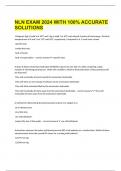
-
NLN EXAM 2024 WITH 100% ACCURATE SOLUTIONS
- Exam (elaborations) • 33 pages • 2024
- Available in package deal
-
- $14.49
- + learn more
NLN EXAM 2024 WITH 100% ACCURATE SOLUTIONS 1 kilogram (kg) of solid X at 10°C and 1 kg of solid Y at 10°C each absorb 5 joules of heat energy. The final temperatures of X and Y are 15°C and 20°C, respectively. Compared to X, Y must have a lower specific heat. conductive heat. heat of fusion. heat of vaporization. - correct answer specific heat. A drop of dilute ammonium hydroxide (NH4OH) is placed on one side of a slide containing a large number of swimming paramecium. Under th...
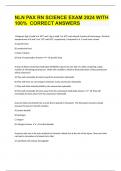
-
NLN PAX RN SCIENCE EXAM 2024 WITH 100% CORRECT ANSWERS
- Exam (elaborations) • 12 pages • 2024
-
- $16.49
- + learn more
1 kilogram (kg) of solid X at 10°C and 1 kg of solid Y at 10°C each absorb 5 joules of heat energy. The final temperatures of X and Y are 15°C and 20°C, respectively. Compared to X, Y must have a lower A) specific heat B) conductive heat C) heat of fusion D) heat of vaporization Answer - A) specific heat A drop of dilute ammonium hydroxide (NH4OH) is placed on one side of a slide containing a large number of swimming paramecium. Under this condition, which of these behaviors of the pa...

-
NLN Practice Questions and Answers with complete solution
- Exam (elaborations) • 33 pages • 2024
- Available in package deal
-
- $8.39
- + learn more
1 kilogram (kg) of solid X at 10°C and 1 kg of solid Y at 10°C each absorb 5 joules of heat energy. The final temperatures of X and Y are 15°C and 20°C, respectively. Compared to X, Y must have a lower specific heat. conductive heat. heat of fusion. heat of vaporization. - Answer-specific heat. A drop of dilute ammonium hydroxide (NH4OH) is placed on one side of a slide containing a large number of swimming paramecium. Under this condition, which of these behaviors of the paramecia wi...
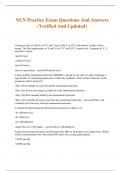
-
NLN Practice Exam Questions And Answers (Verified And Updated)
- Exam (elaborations) • 29 pages • 2024
- Available in package deal
-
- $13.49
- + learn more
NLN Practice Exam Questions And Answers (Verified And Updated) 1 kilogram (kg) of solid X at 10°C and 1 kg of solid Y at 10°C each absorb 5 joules of heat energy. The final temperatures of X and Y are 15°C and 20°C, respectively. Compared to X, Y must have a lower specific heat. conductive heat. heat of fusion. heat of vaporization. - answerspecific heat. A drop of dilute ammonium hydroxide (NH4OH) is placed on one side of a slide containing a large number of swimming paramecium. U...
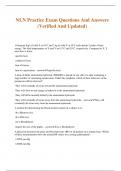
-
NLN Practice Exam Questions And Answers (Verified And Updated)
- Exam (elaborations) • 29 pages • 2024
- Available in package deal
-
- $13.49
- + learn more
NLN Practice Exam Questions And Answers (Verified And Updated) 1 kilogram (kg) of solid X at 10°C and 1 kg of solid Y at 10°C each absorb 5 joules of heat energy. The final temperatures of X and Y are 15°C and 20°C, respectively. Compared to X, Y must have a lower specific heat. conductive heat. heat of fusion. heat of vaporization. - answerspecific heat. A drop of dilute ammonium hydroxide (NH4OH) is placed on one side of a slide containing a large number of swimming paramecium. U...
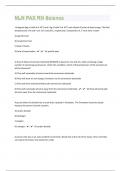
-
NLN PAX RN Science 50 Questions With Answers
- Exam (elaborations) • 13 pages • 2023
- Available in package deal
-
- $6.99
- + learn more
1 kilogram (kg) of solid X at 10°C and 1 kg of solid Y at 10°C each absorb 5 joules of heat energy. The final temperatures of X and Y are 15°C and 20°C, respectively. Compared to X, Y must have a lower A) specific heat B) conductive heat C) heat of fusion D) heat of vaporization - ️️A) specific heat A drop of dilute ammonium hydroxide (NH4OH) is placed on one side of a slide containing a large number of swimming paramecium. Under this condition, which of these behaviors of the par...
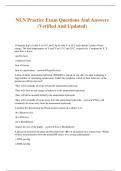
-
NLN Practice Exam Questions And Answers (Verified And Updated)
- Exam (elaborations) • 29 pages • 2024
- Available in package deal
-
- $13.49
- + learn more
NLN Practice Exam Questions And Answers (Verified And Updated) 1 kilogram (kg) of solid X at 10°C and 1 kg of solid Y at 10°C each absorb 5 joules of heat energy. The final temperatures of X and Y are 15°C and 20°C, respectively. Compared to X, Y must have a lower specific heat. conductive heat. heat of fusion. heat of vaporization. - answerspecific heat. A drop of dilute ammonium hydroxide (NH4OH) is placed on one side of a slide containing a large number of swimming paramecium. U...
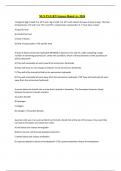
-
NLN PAX RN Science Rated A+ 2024
- Exam (elaborations) • 11 pages • 2024
-
- $9.49
- + learn more
NLN PAX RN Science Rated A+ 2024 1 kilogram (kg) of solid X at 10°C and 1 kg of solid Y at 10°C each absorb 5 joules of heat energy. The final temperatures of X and Y are 15°C and 20°C, respectively. Compared to X, Y must have a lower A) specific heat B) conductive heat C) heat of fusion D) heat of vaporization A) specific heat A drop of dilute ammonium hydroxide (NH4OH) is placed on one side of a slide containing a large number of swimming paramecium. Under this condition, w...

-
NLN Pax Science Practice Test
- Exam (elaborations) • 11 pages • 2024
- Available in package deal
-
- $10.99
- + learn more
NLN Pax Science Practice Test Specific heat 1 kilogram (kg) of solid X at 10°C and 1 kg of solid Y at 10°C each absorb 5 joules of heat energy. The final temperatures of X and Y are 15°C and 20°C, respectively. Compared to X, Y must have a lower a.) specific heat. b.) conductive heat c.). heat of fusion d.). heat of vaporization. They will eventually all swim away from the ammonium hydroxide is the correct answer A drop of dilute ammonium hydroxide (NH4OH) is placed on one side of a ...
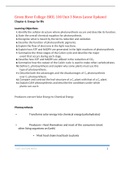
-
Green River College: BIOL 100 Unit 3 Notes Latest Updated,100% CORRECT
- Class notes • 116 pages • 2023
-
- $16.99
- 1x sold
- + learn more
Green River College: BIOL 100 Unit 3 Notes Latest Updated Chapter 6: Energy for life Learning Objectives: 1. Identify the cellular structure where photosynthesis occurs and describe its function. 2. State the overall chemical equation for photosynthesis. 3. Recognize what is meant by the terms reduction and oxidation. 4. Describe the function of photosynthetic pigments. 5. Explain the flow of electrons in the light reactions. 6. Explain how ATP and NADPH are generated in the light reac...

How much did you already spend on Stuvia? Imagine there are plenty more of you out there paying for study notes, but this time YOU are the seller. Ka-ching! Discover all about earning on Stuvia


